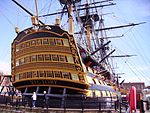HMS M33

HMS M33 is an M29-class monitor of the Royal Navy built in 1915. She saw active service in the Mediterranean during the First World War and in Russia during the Allied Intervention in 1919. She was used subsequently as a mine-laying training ship, fuelling hulk, boom defence workshop and floating office, being renamed HMS Minerva and Hulk C23 during her long life. She passed to Hampshire County Council in the 1980s and was then handed over to the National Museum of the Royal Navy in 2014. A programme of conservation was undertaken to enable her to be opened to the public. HMS M33 is located within Portsmouth Historic Dockyard and opened to visitors on 7 August 2015 following a service of dedication. She is one of only three surviving Royal Navy warships of the First World War and the only surviving Allied ship from the Gallipoli Campaign, the other being the Ottoman minelayer Nusret, preserved in Çanakkale.
Excerpt from the Wikipedia article HMS M33 (License: CC BY-SA 3.0, Authors, Images).HMS M33
The Hard, Portsmouth Portsea
Geographical coordinates (GPS) Address Website Nearby Places Show on map
Geographical coordinates (GPS)
| Latitude | Longitude |
|---|---|
| N 50.801861111111 ° | E -1.11065 ° |
Address
Portsmouth Historic Dockyard
The Hard
PO1 3LJ Portsmouth, Portsea
England, United Kingdom
Open on Google Maps










